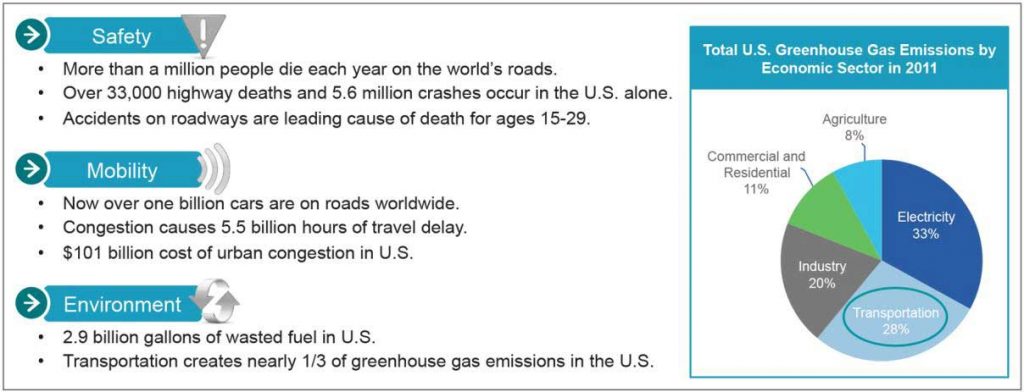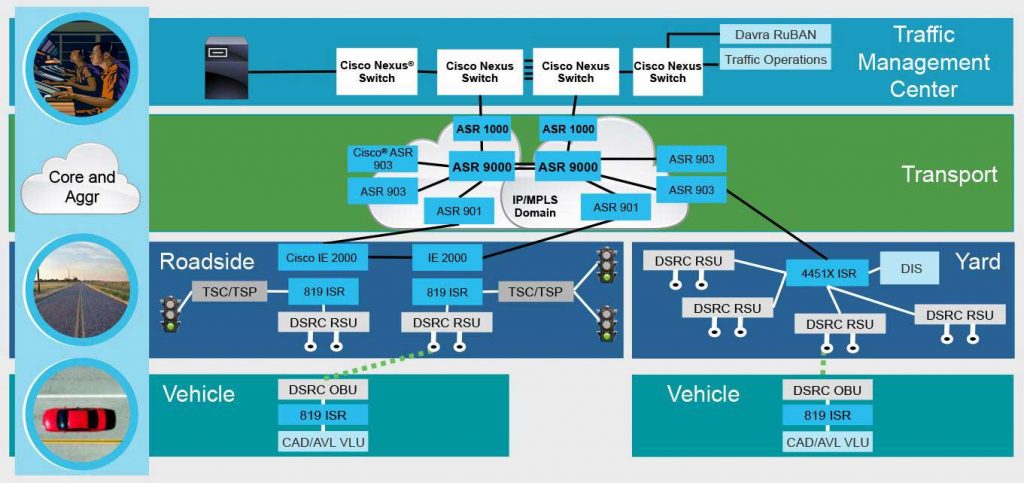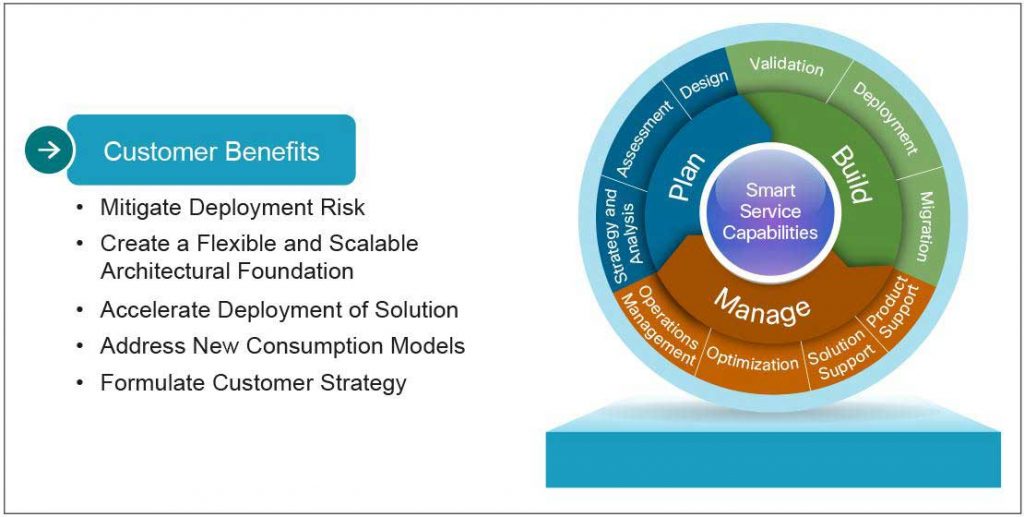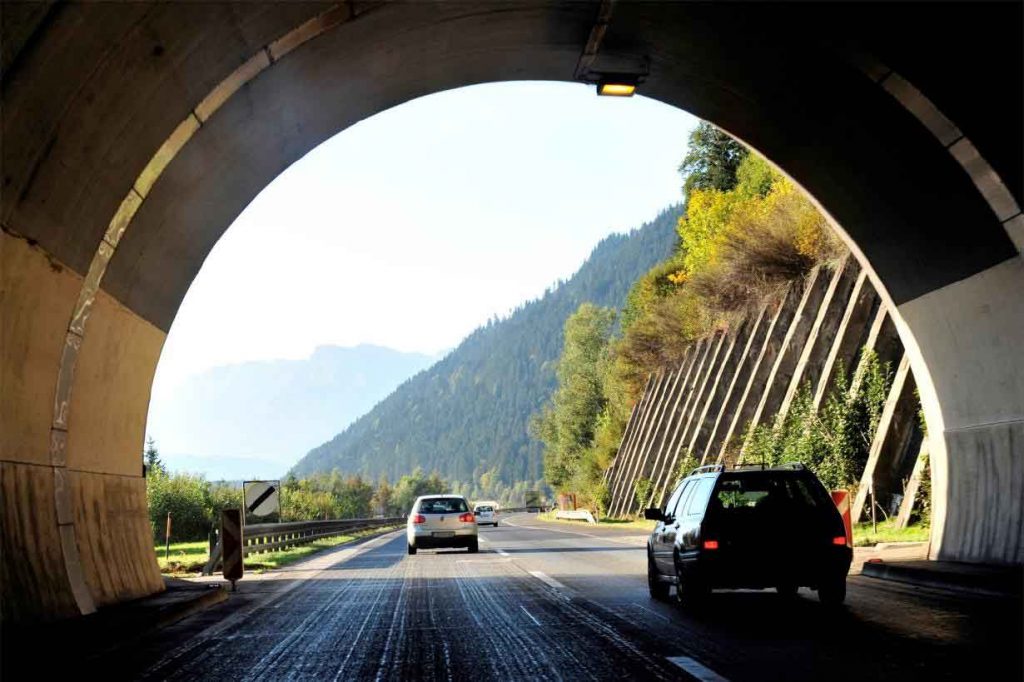What if traffic lights, parking meters, other roadside infrastructure, cars, city buses and emergency vehicles could communicate with one another, making roads safer and less congested? At Cisco, we are helping make that possible.
BENEFITS
- Enhance safety with faster incident response, congestion control, and weather and traffic alerts.
- Reduce fuel costs and wasted time by delivering accurate, timely information to motorists and mass transit agencies about traffic and road conditions.
- Extend the usefulness of existing infrastructure and reduce costs with a flexible, scalable design of open, standards-based network architectures
- Enable new opportunities for innovative roadside services and applications, such as smart parking.
- Help control air pollution by reducing idling and making public transit more reliable and attractive.
Connected roadway technologies are transforming the driving experience in cities across the world – and opening a new world of possibilities. With over a million road deaths every year across the globe, these technologies can help save many lives. They can also reduce the 5.5 billion hours of travel delay caused by congestion just in the United States alone. And reduce the 2.9 billion additional gallons of fuel and subsequent greenhouse gas emissions from idling vehicles. Imagine how much safer, more mobile, and more efficient our roads and highways could be if connected together in an intelligent network infrastructure.
The Cisco® Connected Roadways solution helps us achieve it all. It securely connects separate intelligent transportation systems (ITS) to link cars, buses, trucks, emergency vehicles, and traffic lights. The solution also connects roadside equipment including video cameras and lights, and personal mobile devices – making streets and highways safer and even the busiest corridors more efficient.
City and transportation agencies benefit from more-informed decision making and can reduce operating and maintenance costs. Drivers and commuters benefit from safer roads, less congestion, and more available services.
As the ITS infrastructure evolves, connected roadway solutions will also evolve to include vehicle-to-everything (V2X) communication capabilities. V2X encompasses both V2V and V2I communications and takes connectivity to the next level beyond the vehicles and the traditional ITS infrastructure to include many other devices for connecting people, bicycles, and just about anything that is near or along the roadside.

Shifting Gears to Keep Pace with Evolving Transportation Landscape
Advances in technology, social and economic changes, and legislative policies are altering transportation expectations and needs.
Technological Changes
Many of the networks supporting roadways, tunnels, bridges, mass transit, and some public safety operations were built decades ago on proprietary solutions. These aging, disparate networks are growing prohibitively expensive to operate and manage. Fragmented communications among them creates gaps in connectivity. That introduces inefficiency, and safety risks to passengers, first responders, and other citizens.
Technology continues to change, giving us many more tools to improve safety and efficiency. But the key to making those tools work is a safe, secure, interoperable wired and wireless communications network. A network that links cars, buses, trucks, emergency vehicles, traffic lights, roadside equipment including video cameras and lights, personal mobile devices, and the entire transportation infrastructure.
Social and Economic Changes
Continuing urbanization is driving the need for more efficient transportation systems. And an aging population will require us to put more focus on helping people with limited mobility get around their communities. Another issue is that global supply chains have disrupted traffic patterns in many countries. As countries go from insourcing to outsourcing and then go from outsourcing to insourcing, again, supply chains are continually, dynamically being rerouted. This causes major new influxes of trucking and logistics companies to handle the freight associated with those changes.
New Safety and Security Needs
As technology evolves, so do regulatory policies. Safety and security requirements are being upgraded to keep pace with changing technology capabilities. Air quality regulations are becoming stricter, too, prompting transportation officials to look for new ways to ease congestion and reduce pollution. And for safety reasons, transportation and public safety organizations need to augment their existing radio and limited data networks with video and real-time data solutions. These solutions give first responders and operators the contextual awareness they need to operate safely and effectively in a variety of situations, including lifethreatening incidents, as well as daily operations.

How Cisco Connected Roadways Works
The Cisco Connected Roadways solution securely connects disparate intelligent transportation systems. It addresses interoperability requirements based on the Connected Vehicle Reference Implementation Architecture sponsored by the U.S. Department of Transportation (USDOT) Intelligent Transportation System (ITS) Joint Program Office.
While the initial focus of Connected Roadways is V2I communications, we will add functionality such as full V2X communication and additional V2V applications as the ITS evolves and more ITS products become available. It may be helpful to think of Connected Roadways as the infrastructure that connected vehicles will drive on.
Built on Open Standards
The Cisco Connected Roadways architecture and validated network designs are built on open standards. This lowers your total cost of ownership, reduces your implementation risks, and makes it easier to deliver applications. Our platform lets you take advantage of commercially available products and services to lower costs and protect existing infrastructure investments while improving performance. For example, Dedicated Short Range Communications (DSRC) roadside units and radios located on highways and bridges and in vehicles communicate with intelligent applications in traffic management centers to help improve safety, reduce emergency response times, and better communicate traffic flows.
Components of Connected Roadways
Cisco Connected Roadways consists of a fully implemented Cisco IP Next Generation Network (IP NGN) that incorporates legacy systems, new enterprise collaboration applications, and best-of-breed technology products from Cisco and our partners.
The main components are onboard systems in vehicles; roadside devices and infrastructure; networked operations facilities and yards; and centralized traffic management centers. Following is a summary of each component that has been tested and validated for interoperability in the Cisco Connected Roadways solution.
A Quick Look: Cisco Validated Connected Roadways Components
| Cisco Products | Description |
| ISR 819 Router | ● Vehicle router connects onboard systems to wireless DSRC radio ● Roadside router connecting roadside DSRC radio to citywide Unified MPLS transport network |
| IE2000/3000/4000 Ethernet Switches | ● Ruggedized Ethernet switches provide transport connectivity to the roadside equipment components |
| ISR 3945 and 4451-X Routers | ● Hub router for maintenance yard networks |
| ASR 900 Series Router | ● Provides scalable and resilient Unified MPLS transport infrastructure, interconnectivity between roadside, yard, data center, and operations center networks |
| ASR 1000 Series Router | ● Provides hub routing functionality for management of mobility for and communications to and from vehicles moving around the roadside infrastructure |
Other components that are not directly part of the system: Cisco UCS® for data center infrastructure.
| Third-Party Tested Products | Description |
| DSRC Radios | ● DSRC hardware for both onboard (OBU) and roadside (RSU) roles, to provide wireless communications between vehicles and roadside equipment for V2I services |
| Econolite Cobalt ATC | ●Advanced Traffic Controller (ATC) from Econolite provides automated traffic signal control and management ● http://cobalt.econolite.com/ |
| Iteris TransitHelper Processor | ●The Iteris TransitHelper Processor provides black box functionality for transit signal priority (TSP) handling, receiving TSP requests from vehicles, and signaling the appropriate action to the ATC ● http://www.iteris.com/products/processors/transithelper |
| Davra RuBAN Management System | ● The RuBAN system provides a comprehensive network management system, as well as a data analytics and management platform for monitoring vehicle performance and metrics |
| Xerox CAD/AVL System | ● Vehicle onboard system responsible for generating TSP requests when approaching an intersection |
Services supported in the Cisco Connected Roadways systems are TSP and wireless bulk data transfer (WBDT).
Cisco Connected Roadways Infrastructure: A Closer Look
Vehicle Onboard Network and Systems
The vehicle on-board network consists of three components:
- Xerox Vehicle Logic Unit (VLU): provides computer-aided dispatch and automated vehicle location (CAD and AVL) functions for the vehicle.
- Cisco ISR 819 Mobile Router: provides IP routing and networking for the Xerox VLU and other systems in future Cisco Connected Roadways phases.
- DSRC Onboard Unit (OBU): provides wireless connectivity for the Cisco ISR 819 Mobile Router and systems behind it. The DSRC OBU has unmatched radio performance in harsh outdoor and mobile environments, including critical safety use-case scenarios.
The wireless system providing the V2I connectivity implements a DSRC infrastructure. DSRC is a two-way, shortto medium-range wireless communications system that permits very high data transmission critical in communications-based active safety applications.

Roadside Devices and Infrastructure
Each roadside intersection has a DSRC roadside unit (RSU) connected to a Cisco 819 Integrated Services Router along with the TSC and a TSP processor. These are all connected to the metrowide transport network through Ethernet. The roadside devices are ruggedized to withstand harsh environmental conditions. They can be connected to the transport network through either a fiber or copper connection. Additional roadside equipment, such as IP video surveillance cameras or wireless access points, can also be connected to the infrastructure network. When connected to a Cisco Industrial Ethernet switch, the devices can then connect directly to the access nodes of the transport network.
Roadside network infrastructure includes:
- Cisco ISR 819 Mobile Router: Can be used as the roadside router connecting roadside DSRC radios to citywide Unified MPLS transport network.
- Cisco IE 2000, 3000, and 4000 Industrial Ethernet Switches: ruggedized Ethernet switches provide transport connectivity to other roadside equipment components.
- Cisco ASR 900 Series Aggregation Services Router: provides scalable and resilient Unified MPLS transport infrastructure and interconnectivity between roadside, maintenance yard, data center, and traffic management center networks.
- ASR 1000 Series router: provides hub routing functionality for management of mobility and for communications to and from vehicles moving around the roadside infrastructure.
- Econolite Cobalt Advanced Traffic Controller (ATC): provides automated signal control and management functionality.
- Iteris TransitHelper TSP Processor: provides black box functionality for TSP handling and receiving TSP requests from vehicles to signal the appropriate action to the ATC.
- Road Side Unit (RSU): Comes in a NEMA4 weatherproof enclosure with integrated antennas and a pole mounting kit. Dual antennas maximize range and coverage to cover all approaches to an intersection with a single, self-contained unit that also supports Power over Ethernet (PoE).
Yard and Operations Facilities Networks
Multiple DSRC radios are deployed to provide complete coverage of the maintenance yard, with the exact number of radios being dependent upon the size of the yard and the number of vehicles parked there at any one time.
The DSRC radios for yard operations are aggregated by a Cisco ISR router, either a 3945 or 4451X with an Ethernet Switching Service Module, which provides routing capabilities between the connected buses and the data interface station (DIS) server. Connections are made in a hub-and-spoke topology, with the Cisco ISR router acting as the hub router. This infrastructure provides all routing and wireless communications functions required for implementing wireless bulk data transfer (WBDT) service.

Traffic Management Center or Data Center
Data centers house several of the application servers used in the Cisco Connected Roadways solution. This includes the Back Office Server (BOS), the Virtual Supervisor Module (VSM) application servers (including the Operations Manager and long-term storage), and any other servers that may be found in a data center. These application servers may run directly on physical servers or be virtualized using a hypervisor. The network infrastructure used in the data center may be comprised of the Cisco Nexus® line of data center switches. The Virtualized Multiservices Data Center (VMDC) Cisco Validated Design is used in Cisco Connected Roadways to provide a high-speed, reliable data center network.
Communication between the traffic management center and onboard devices relies on a redundant and resilient bidirectional communications network spanning from the traffic management center to the roadside. The hierarchical design of the transport network provides a resilient communications path between the field devices and the data center. This includes ruggedized Ethernet switching at the edge and a multipath unified Multiprotocol Label Switching (MPLS) transport network with subsecond reconvergence.
Connected Roadways Service Delivery Platform and Management
Davra Networks RuBAN platform is an Internet of Things (IoT) service delivery platform, consisting of four key components: deployment, device management, visualization, and data management. It provides a comprehensive network management system, as well as the data analytics and management platform for monitoring vehicle performance and metrics.
Within the Cisco Connected Roadways solution, the RuBAN platform is used for the following:
- Management of Cisco, DSRC and Road Side Unit (RSU) infrastructure
- Zero-touch provisioning of new network devices
- Network performance and alert monitoring
- Integration of geolocation information
Use Cases for Connected Roadways
| Traffic light control | ● Allow mass transit or emergency vehicles to change traffic signals as they approach intersections. ● Alert drivers that emergency vehicles are approaching by sending messages to their cars’ on-board systems |
| Street light management | ● Provide continuous power to Wi-Fi access points, video cameras, and more, using smart devices installed on poles. ● Improve monitoring and control of dimming and usage. ● Detect maintenance needs. ● Enable connected vehicle technologies |
| Smart parking | ● Monitor in real time whether a parking spot is occupied or vacant. ● Enable people to pay for parking without contact (through near field communications). ● Monitor parking zones to measure and respond to parking needs and behaviors. ● Ensure that only authorized vehicles park in business and loading zones. |
| Traffic incident management | ● Reduce time to detect, verify, and categorize incidents, speeding response time. ● Better manage traffic congestion. |
| Vehicle-to-vehicle communication | ● Allow data sharing between smart cars of the future as well as between emergency vehicles, city buses, and commercial fleets by installing infrastructure needed to create standard communication protocols. |
| Smarter cars | ● Manage security policies for V2V connectivity. ● Enable real-time mobility and weather data to be shared between disparate vehicle types and transportation centers. ● Connect multiple in-car sensors so multiple measurements can be centrally analyzed to produce actionable intelligence. ● Provide motorists with a more secure, reliable, and fast way to download content and access cloud services. ● Permit vehicle sensors to interact with third-party applications such as GPS and mapping to enable dynamic rerouting to avoid accidents and other hazards |
applications enabled by the underlying infrastructure of Cisco Connected Roadways.
Tap Our Expertise for Smooth Deployment Services
We provide advanced services to help you plan, build, and manage your Cisco Connected Roadways solutions. Our services team can help with design, validation testing, and migration from legacy systems. And our TS and AS teams can stay on for continuing operations, management, and technical support.
Take advantage of our industry-leading experience to improve operational efficiency, scalability, security, and profitability with an end-to-end approach that aligns outcomes to your business goals. We can help you:
- Mitigate deployment risk
- Create a flexible and scalable architectural foundation
- Accelerate deployment of solution
- Formulate customer strategy

Transportation Organization Enhances Safety with Robust IP Network
Challenge: ASFiNAG, a state-owned company since 1982, oversees the planning, building, maintenance, and operations of more than 2200 kilometers of motorways and expressways and 400 kilometers of tunnels in Austria. To reduce congestion and increase the operational efficiency of its network by delivering timely information and reliable communication, ASFiNAG needed a robust network infrastructure that could support data, voice, and video. The solution would have to be highly intelligent, prioritize latency-sensitive traffic and maintain optimal sound and picture quality. And because many of Austria’s motorways pass through the Alps, the solution needed to be extremely rugged to work dependably in cold, snowy conditions.
Cisco Connected Roadways securely connects separate intelligent transportation systems to make streets and highways safer and make even the busiest corridors more efficient. Soon, drivers will have tools to anticipate potential crashes, reducing the number of lives lost each year.
Solution: ASFiNAG has connected more than 70,000 sensors and 6500 traffic cameras over a fiber-optic network that gives them live feedback on their roads, bridges, and tunnels. Using this sensor data, they are able to help better route emergency vehicles and provide drivers with up-to-date information. They can even adjust speed limits automatically to alleviate traffic jams based on traffic flow data and other parameters.
The end-to-end Cisco MPLS fiber infrastructure is designed for efficiency, scalability, and security. The comprehensive IP network solution features a wide range of Cisco products, designed specifically for harsh environments. These include:
- Cisco Industrial Ethernet 3000 Series Switches
- Cisco 3925 Integrated Services Router
- Cisco 7609 and 7201 Routers, and 3845 Integrated Services Router
- Cisco Catalyst 2955, 3750, 2960 Series Switches
- Cisco ME 3400 Series Ethernet Access Switches
- Cisco IP Interoperability and Collaboration System (IPICS)
- Cisco ASA 5500 Series Adaptive Security Appliance
- Cisco UCS servers
- Cisco Aironet® Series wireless access points
Benefits
- Rugged industrial switches, routers, and access points deliver dependable operation in challenging mountain winters and support bandwidth-intensive video surveillance of traffic.
- Single-vendor solution streamlines deployment and operation, reducing TCO.
- Flexible, scalable design supports continued growth while minimizing additional capital expenses
- IP-based dispatch and incidence response solution enhances public safety.
- Network supports digital signage, which is essential for keeping motorists informed.











